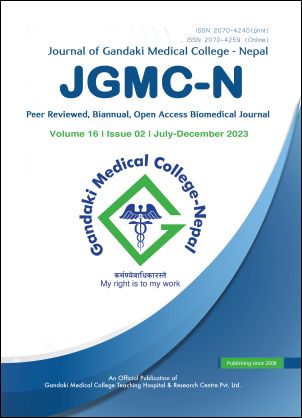Evaluation of renal arteries in hypertensive patients by multi-detector computed tomography
DOI:
https://doi.org/10.3126/jgmcn.v16i2.59349Keywords:
Angiography, hypertension, Multi detector computed tomography, renal arteryAbstract
Introduction: Among various causes of hypertension, only 1 to 2% is renovascular hypertension which may be characterized by the various reasons in renal vascular supply. Multi-detector computed tomography is used to know about the details of the vascular structures in patients. This study aims to evaluate the renal arteries in hypertensive patients.
Methods: A prospective observational study was conducted among 93 hypertensive patients. Contrastenhanced computed tomography of the abdomen and pelvis was conducted, and measurements were obtained from the axial section of the maximum intensity projection image. Data were analyzed using SPSS version 23.0. Independent t-test and Pearson’s Correlation were used. The level of statistical significance was set at p<0.05.
Results: The study found mean lengths for the right and left main renal arteries to be 40.33±10.26 mm and 32.36±9.55 mm, and diameters were 4.31±0.86 mm and 4.16±0.81 mm. No significant sex-based differences were observed. However, a significant age-related difference was noted in the length (p=0.012) and diameter (p=0.036) of the right main artery within the 20 to 29 and 80 to 89 years age groups. Weak correlations were observed between left renal artery length and age (r=0.221, p=0.33) and mean right renal artery diameter and age (r=-0.218, p=0.036). Prevalence of accessory renal arteries and early branches was 19.35% and 16.10% respectively.
Conclusions: This study found that there were no statistically significant differences in renal arteries dimensions of hypertensive patients with different age groups and genders. Although the proportion of early renal artery branching and accessory arteries are found to be similar to previous studies there may be other associated factors for all hypertensive patients who don’t have early renal branches or accessory arteries.
Downloads
Downloads
Published
How to Cite
Issue
Section
License
Copyright (c) 2023 Pradip Sharma, Ms. Sushma Singh, Saroj Sharma, Rajesh Prasad Yadav, Avinesh Shrestha, Suraj Sah, Pratibha Panta, Rabina Sapkota

This work is licensed under a Creative Commons Attribution-NonCommercial 4.0 International License.
This license allows reusers to distribute, remix, adapt, and build upon the material in any medium or format for noncommercial purposes only, and only so long as attribution is given to the creator.




